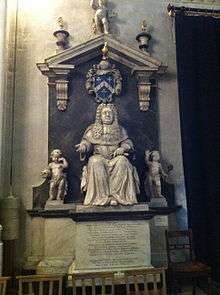Sir James Reynolds, junior

Sir James Reynolds (1686-1739) was Lord Chief Baron of the Exchequer from 1730 to 1738. He should not be confused with a close relative (most likely his nephew) Sir James Reynolds who was Chief Justice of the Irish Common Pleas in the same era.
He was the son of James Reynolds of Helions Bumpstead in Essex and his second wife Bridget Parker.[1] He entered Lincoln's Inn and was called to the Bar in 1712; he became Serjeant-at-law after only two years. He sat in the House of Commons as member for Bury St. Edmunds and was also Recorder of the town.[2]
As a barrister his most notable case was the celebrated lawsuit on the question as to whether King George I had sole rights over the care and education of his grandchildren (1718).[3] He argued unsuccessfully that the future King George II had the right to determine how his children should be educated. George I seems not to have born any grudge against Reynolds and appointed him a judge of the Court of King's Bench in 1725. George II made him Chief Baron in 1730; he retired, apparently for health reasons, in 1738 and died the following February. He was buried in St. Edmundsbury Cathedral, and a memorial was raised to him there. He married twice, firstly to Mary Smith and secondly to Alice Rainbird, but had no children.[4]
Foss praises him as a judge who throughout his career endeavoured to do his duty "without fear or affection, prejudice or passion".[5]
The year after his death another Sir James Reynolds, who had been Chief Justice of Common Pleas in Ireland, was appointed a Baron of the Exchequer.[6] Their precise relationship has been a matter of some debate, but it seems that the Chief Baron, though two years younger, was the Irish Chief Justice's uncle,[7] the latter being the son of Robert Reynolds, a much older half- brother of the Chief Baron.
References
| Legal offices | ||
|---|---|---|
| Preceded by Sir Thomas Pengelly |
Chief Baron of the Exchequer 1730–1736 |
Succeeded by Sir John Comyns |